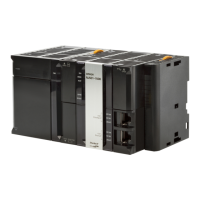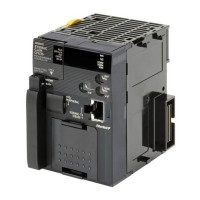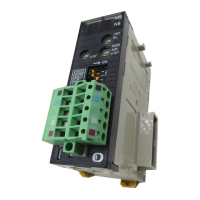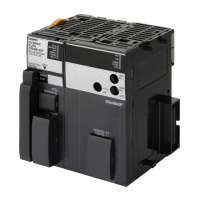21
Precautions for Safe Use
NX-series EtherNet/IP Coupler Unit User’s Manual (W536)
Units that supply power continue to supply power to the Units for up to several seconds after the
power supply is turned OFF. The PWR indicator remains lit as long as power is supplied. Confirm that
the PWR indicator is not lit before you perform any of the above.
• Confirm that the controlled system will not be adversely affected before you perform any of the fol-
lowing operations.
Changing the operating mode of the CPU Unit or Industrial PC (including changing the setting of the
Operating Mode at Startup)
Changing the user program or settings
Changing set values or present values
Forced refreshing
• Always sufficiently check the safety at the connected devices before you change the settings of a
slave or Unit.
• Make sure that the communications distance, number of nodes connected, and method of connec-
tion for EtherNet/IP are within specifications.
Do not connect EtherNet/IP Coupler Units to an EtherCAT network.
• Malfunctions or unexpected operation may occur for some combinations of EtherNet/IP revisions of
the master and slaves. If you disable the revision check in the network settings, check the slave revi-
sion settings in the master and the actual slave revisions, and then make sure that functionality is
compatible in the manuals or other references. You can check the slave versions in the settings from
the Support Software and you can check the actual slave revisions from the Support Software or on
slave nameplates.
• After you transfer the user program, the CPU Unit is restarted and communications with the Ether-
Net/IP slaves are cut off. During that period, the slave outputs behave according to the slave settings.
The time that communications are cut off depends on the EtherNet/IP network configuration.
Before you transfer the user program, confirm that the system will not be adversely affected.
• EtherNet/IP communications are not always established immediately after the power supply is turned
ON. Use the slave terminal status bits in the user program to confirm that communications are estab-
lished before attempting control operations.
• If frames sent to EtherNet/IP slaves are lost due to noise or other causes, slave I/O data is not com-
municated, and the intended operation is sometimes not achieved. Perform the following processing
if noise countermeasures are necessary.
Program the Slave Terminal Status (refer to 9-2-3 I/O Allocation Information on page 9-12) and/or
Unit status CIO bits as an interlock condition in the user program.
Refer to the CS and CJ Series EtherNet/IP Units Operation Manual (Cat. No. W465) for details.
• When an EtherNet/IP slave is disconnected, communications will stop and control of the outputs will
be lost not only for the disconnected slave, but for all slaves connected after it. Confirm that the sys-
tem will not be adversely affected before you disconnect a slave.
• If you disconnect the cable from an EtherNet/IP slave to disconnect it from the network, any current
communications frames will be lost. If frames are lost, slave I/O data is not communicated, and the
intended operation is sometimes not achieved. Perform the following processing for a slave that
needs to be replaced.
Program the Slave Terminal Status (refer to 9-2-3 I/O Allocation Information on page 9-12) and/or
Unit status CIO bits as an interlock condition in the user program.
Refer to the CS and CJ Series EtherNet/IP Units Operation Manual (Cat. No. W465) for details.
• Separate the EtherNet/IP communications from the office network to avoid EtherNet/IP communica-
tion failures.
Operation
EtherNet/IP Communications

